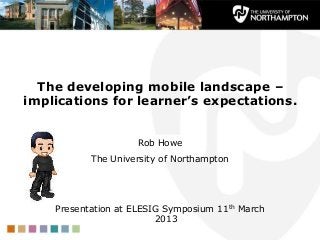
Learners experience of mobile
- 1. The developing mobile landscape – implications for learner’s expectations. Rob Howe The University of Northampton Presentation at ELESIG Symposium 11th March 2013
- 2. 3-years of trend data Growth in 2012 compared to (2011) •Laptop ownership 88.2% (86%) •Smartphone 83.4% (58%) •Tablets 37.5% (21%) •E-Book reader 27.3% (18%) Technology ownership Dec 2012 (N=938) 100 80 60 40 20 Planning to own 0 Portable Media… Already own Standard… Handheld… Assistive… Gaming device Smartphone Tablet device Laptop ebook reader Digital camera Audio Recorder
- 3. Learner Considerations 1. Inclusion (device and connectivity) 2. Accessibility (choice, personalisation, control) 3. Usability and training See the Learntech blog for more on this
- 4. Developing a supportive infrastructure Different audiences (students, staff, prospects) What’s possible? Learner’s will expect support Services rated 'useful' 100 80 60 40 20 0
- 5. Need to join up University approaches CIS (Timetabling) Marketing Course info Mobile web page Jpg files Flickr Youtube Web Library Staff directory team Systems Talis integration Events listings LearnTech News feeds Blackboard Learn
- 6. Creating mobile learning opportunities • Introducing Mobile Learn to staff – course design considerations – support resources – inspiration / case studies: http://bit.ly/uonmobileart Mobile for fieldwork
- 7. Is it working? Feedback from users Being able to post via a mobile means • Twitter Bloody good idea! work in progress can (#iNorthampton) be recorded in situ • Email and shared • Blog spontaneously. @UniNorthants now • Spot surveys have their own app. • Focus groups Snazzy. • Pilots Can access NILE when ever I need to and if I need to Am not tryna gas but check something quickly I thank God for the can do. Also comes in handy Northampton app because if can’t see properly in now I left my timetable at lectures as can bring them home, I would have been up on my phone. lost.
- 8. Top five tips 1. Identify needs (and decide which ones you can meet) 2. Develop a supportive infrastructure 3. Plan provision for mobile devices 4. Ensure inclusiveness 5. Stay in the loop.....
- 10. References etc. Useful links • More about the iNorthampton project: http://www.northampton.ac.uk/mobile • Guidelines on accessibility for the mobile web: http://www.w3.org/Mobile/ • TechDis on mobile learning: http://www.jisctechdis.ac.uk/techdis/investinyourself/freeresources/accessiblemobile learning • Traxler, J. (2010) “Students and mobile devices.” ALT-J Research in Learning Technology [online] 18.2, p149-160. Available from: http://www.researchinlearningtechnology.net/index.php/rlt/article/view/10759 [Accessed 10th February 2012] • More info on JADU MyAPI (presentation by Steve Martin): http://speakerdeck.com/u/s2martin/p/inorthampton-and-jadu Image credits • Photography by Rob Farmer, University of Northampton • 3d characters from http://www.canstockphoto.com/3pod
Notas del editor
- Welcome and introductions
- As indicated in Dec 2012, laptop – 88.2% (86%) and smartphone 83.4% (58%) ownership now dominate. The rapid rise in smartphone ownership over the previous year and the increase in tablet ownership 37.5% (21%) is indicating a preference to move to these sorts of devices. 23.5% of respondents are planning to purchase a tablet device in the next 6 months.E-book reader ownership continues to rise 27.3% (18%) but it should be noted that many of the tablets and smartphones may also have E-book reader functionality.Staff and student ownership of smartphones are indicating a preference for IOS 43.6% (45%) and Android 35.8% (33%) devices. Blackberry represents 12% (16%). Other devices accounted for 7% which included Windows 3% (3%).Accessing email 96.5% and accessing NILE 81.8% represent the normal weekly activity of staff and students - 92.7% are accessing email daily. General social networks such as Facebook were being accessed at least once a week by 75% of the sample – this dropped for professional networks to 40.9%.With all types of technology use (personal and work related), a computer / laptop was mostly preferred over a mobile device - however the gap was close with regards to use of Facebook (60% used desktops compared to 58.5% using mobiles). Twitter was the only technology which was used more often on mobile devices (34%) than on desktops (26%). More detailed research is needed to establish whether this preference is simply related to usability (screen size), or whether it reflects the limited provision of ‘mobile-friendly’ services. With regards to patterns of use of mobile devices, 90.8%(80%) use texts and voice calls regularly; 78.7% (56%) regularly use their device to browse the web; 71% use their device to read emails; and 67% (44%) regularly use mobile apps.
- - BYOD model, but also loan devices, campus wireless and portable wifi hotspots-Traxler’s paper on student devices- Accesibility – alternatives/adjustments Google search for ‘university provide ipads’
- Logical progression - the needs determined the team (data sources), then needed a delivery platform (the supplier)
- - informal feedback- focus groups (incl URB@N)- mobile learning pilots 85% of students rate Mobile Learn as ‘useful’ / ‘very useful’Library, Directory and Timetables score over 70%
- Needs – not just data but platforms (Blackberry)Team – project manager, data experts, buy in and branding/consistency (Computing, NBS). Note time difference.
